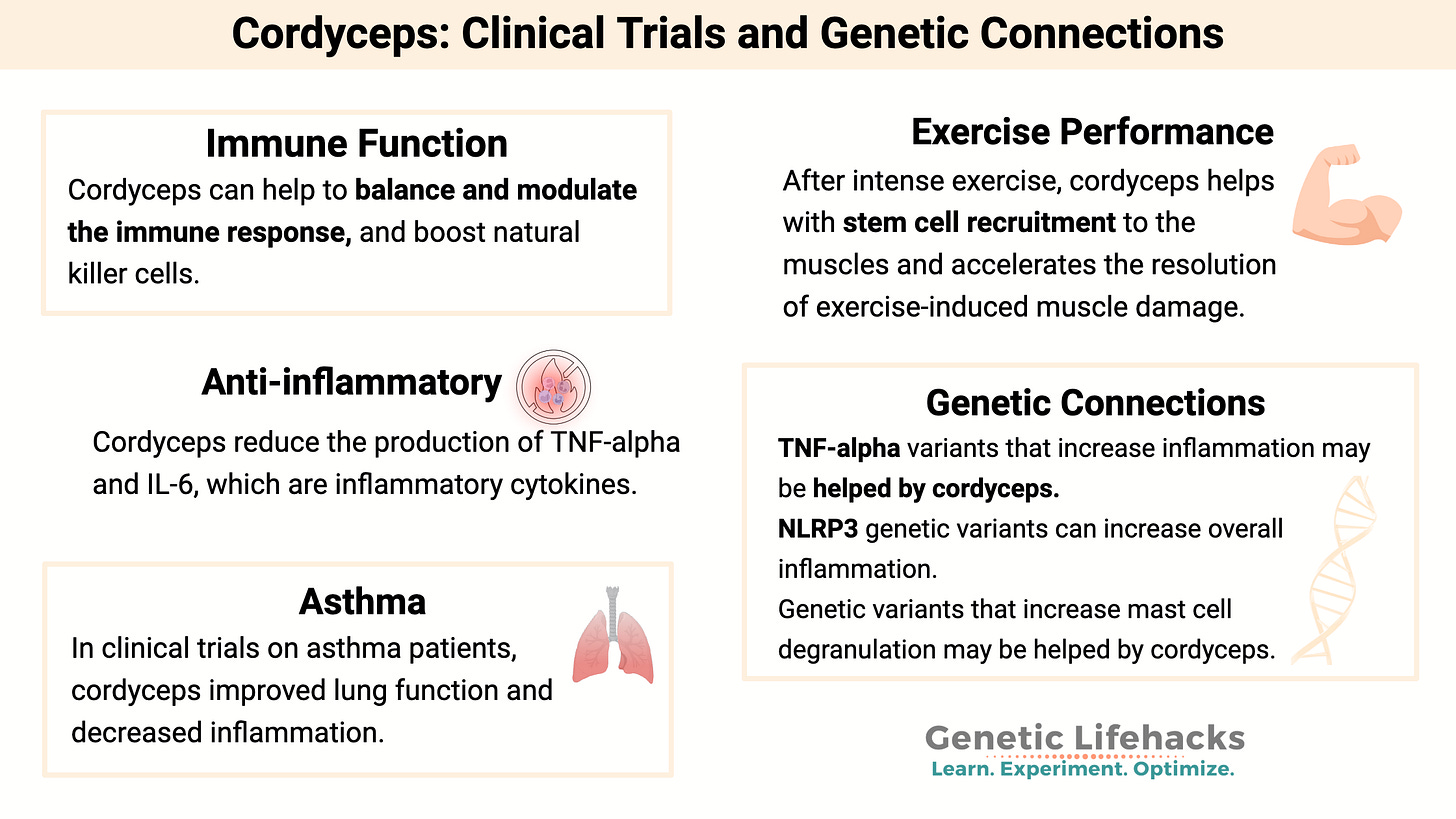Cordyceps: Clinical Trials, Mechanism of Action, and Genetic Connections
Hi everyone,
This week I'm bringing you a new (member requested!) article exploring the research studies on cordyceps mushroom extract.
Used for centuries in Tibetan and Chinese medicine, cordyceps is now being validated by modern research for its wide range of health benefits. Studies show that cordyceps may help improve endurance and respiratory function, balance the immune response, and reduce inflammation. It may also help with asthma, chronic kidney disease, and long-haul COVID. Traditionally, cordyceps is used to increase energy and improve athletic performance. Read the full article to learn about the key active compound, cordycepin, its effects on cellular health, and how genetic and dietary factors may influence its impact.
For those interested in the 23andMe bankruptcy, a few weeks ago I linked to a Regeneron press release announcing their winning bid to take over 23andMe. However, it appears that was not the end of the story! Instead, Anne Wojcicki, the founder and former CEO of 23andMe, is taking back over. All prior policies will remain in place, and data will not be sold or transferred.[ref]
Stay curious,
~ Debbie
New article!Cordyceps: Clinical Trials, Mechanism of Action, and Genetic Connections
Key takeaways:
~ Cordyceps, especially C. militaris, is used as a supplement for enhancing endurance, reducing inflammation, and modulating immune response.
~ Cordycepin is the main active compound in cordyceps.
~ It reduces inflammatory cytokines, such as IL-6 and TNF-alpha, and suppresses the NLRP3 inflammasome.
What is cordyceps, and what are the benefits of taking it as a supplement?
Cordyceps is a genus of medicinal fungi that has been used for centuries in Chinese and Tibetan medicine.[ref] More recently, cordyceps has become a popular supplement due to its performance-enhancing benefits and its role as an adaptogen that modulates the immune response.
There are multiple Cordyceps species. Two that are of interest are:
Cordyceps militaris (C. militaris)
Cordyceps sinensis (C. sinensis, now reclassified as Ophiocordyceps sinensis)
Cordyceps sinensis is the original species used in Tibet and China for centuries for energy, libido, and respiratory health. It’s a parasitic fungus that grows on the ghost moth caterpillars, high up in the Himalayas. Due to overharvesting, it’s now a threatened species, and the harvesting of it in the wild is regulated and limited. It’s a hard species to grow in artificial cultivation. [ref]
Bioactive compounds in Cordyceps:
Cordycepin is the primary bioactive compound that is studied in C. militaris and C. sinensis. Cordycepin is defined as a nucleoside analog, similar to adenosine, and also known as 3′-deoxyadenosine.[ref] Nucleoside analogs are compounds that mimic the structure of the building blocks of DNA, consisting of a nucleotide plus either ribose or deoxyribose.
Because cordycepin is very similar to adenosine, it is sometimes incorporated into mRNA in place of adenosine, which leads to that mRNA not being translated into its protein. Certain mRNAs are more sensitive to cordycepin, and the effect of cordycepin on RNA polymerase is relatively minor. One protein that is affected is mTOR, and cordycepin at certain levels acts as a mild mTOR inhibitor.[ref][ref][ref]
In addition to cordycepin, C. militaris also contains “cordyceps polysaccharide, cordyceps acid, fatty acids, amino acids, vitamins, ergosterol and myriocin”.[ref]
Cordyceps militaris is a related species that can be more easily cultivated on brown rice, soy, or casein as a substrate. This makes it the main species used in supplements.[ref][ref] It also has a high level of several of the beneficial compounds originally identified in C. sinensis.
Read the rest of the article here
What I've been reading:
1. T and B cell responses against Epstein–Barr virus in primary sclerosing cholangitis
Primary sclerosing cholangitis (PSC) is a serious liver disease. Researchers found that people with PSC have higher levels of anti-Epstein-Barr Virus titers and that mononucleosis (caused by EBV) increased the relative risk of PSC by 12-fold.
Related GL article: Primary sclerosing cholangitis and Epstein-Barr Virus
2. Lifestyle instability: an overlooked cause of population obesity?
There's a common idea that weight gain just creeps up over the course of a year. But it turns out that isn't correct. Instead, it may be that short-term episodes of eating more (holidays, freshman 15) account for much of the yearly increase in weight.





